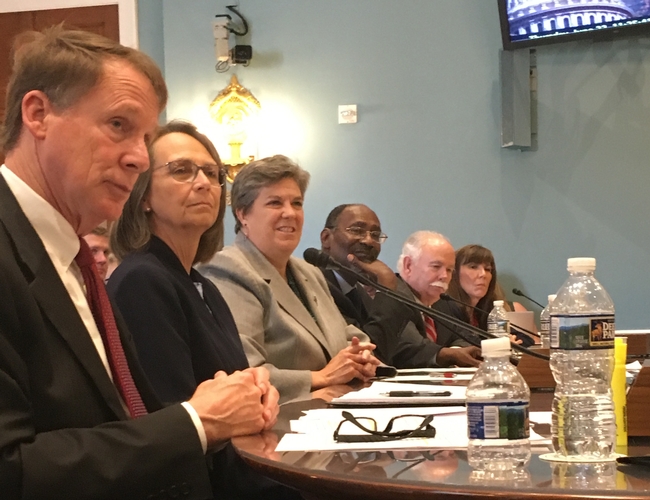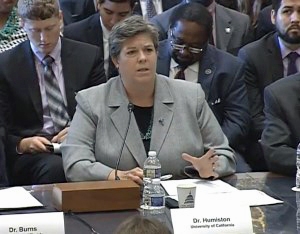Humiston speaks to House Ag Committee on value of agricultural research
“The general public and, in particular, large funders tend to not view agriculture as a particularly sexy topic. We've done such a great job for over 150 years of providing a safe, secure, wonderful, bountiful food supply that people take it for granted,” VP Glenda Humiston told members of the U.S. House of Representatives Committee on Agriculture, explaining the challenges of fundraising for public agricultural research.
“Agricultural research has been essential to U.S. gains in productivity over the past century,” said Agriculture Committee Chairman K. Michael Conaway (TX-11) when he announced the hearing on The Next Farm Bill: University Research. “With the global population expected to reach 9.7 billion by 2050, U.S. production agriculture will continue to be asked to produce more with fewer resources, and the best way to do that will be through strategic investments in agricultural research. I look forward to hearing from university leaders about the opportunities and challenges they face in ensuring American agriculture remains a world leader in cutting-edge technology and research.”
Conaway asked why the universities' agriculture programs lack infrastructure like labs and greenhouses and have $8.4 billion in deferred maintenance.
“As we've dealt with cuts and increased costs, it's been easy to say, ‘We can put off fixing that roof or put off buying that new piece of equipment a few more years if we can keep those researchers doing their work,'” Humiston explained. “Unfortunately, I think that's been going on for decades rather than a few years and that's why it's gotten so critical."
Humiston and the other guests described how their institutions partner with private industry and other government agencies to leverage federal funding.
Highlights of Humiston's remarks
- A vital component of federal support for agricultural research has been capacity funding specifically dedicated to supporting research and Cooperative Extension programs at America's land-grant universities.
- The current mix of federal and state capacity funds is generally leveraged many-fold by federal competitive grants, grants from private industry, and other types of unrestricted gifts and awards to faculty conducting research at the nation's land-grant universities.
- A recent study found the return on investment for federal funding of the public land-grant system averages 21:1, corresponding to annual rates of return between 9 percent and 10 percent.
- With University of California (UC) Agriculture and Natural Resources (ANR) serving as a vital partner, California's $47 billion agricultural sector continues to make California the nation's top agricultural state.
- In the past fiscal year, UC ANR has served more than 1.4 million adults and youth directly, published 1,800 peer-reviewed journal articles and filed more than 20 patents.
- Although progress is being made to incrementally increase appropriations to the USDA Agriculture and Food Research Initiative, it remains funded at considerably less than the $700 million authorized in the previous two Farm Bills.
To watch a recording of the hearing, visit YouTube at https://www.youtube.com/watch?v=ckbfCTTuZs0. Humiston appears at the 24:45 mark.
For a transcript of Humiston's full prepared remarks, visit http://ucanr.edu/files/264186.pdf.
The committee has scheduled listening sessions, “The Next Farm Bill, Conversations in the Field,” to gather input from farmers, ranchers and stakeholders across the country. They will be in California on Aug. 5 in Modesto.


